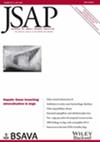Placement, management and complications associated with peripheral intravenous catheter use in UK small animal practice
Abstract
Objectives
To describe the techniques for preparation and placement of peripheral intravenous catheters (PIVCs), to describe the complications associated with PIVCs, and to identify factors associated with PIVC complications in small animal practice in the United Kingdom.
Materials and Methods
A prospective multicentre observational study was undertaken between January 2022 and January 2023. Data collected included patient information, information regarding the placement and maintenance of PIVCs, and PIVC complications, from privately owned cats and dogs presenting to veterinary institutes in the United Kingdom. Patients required a PIVC to be placed as part of their care and the PIVC was anticipated to be in situ for >24 hours to be eligible for PIVC complication analysis.
Results
A total of 19 institutes recorded data regarding 382 PIVCs, with 325 (85.1%) placed in dogs and 57 (14.9%) in cats. The most common reasons for placement were to administer intravenous fluid therapy (74.3%) and intravenous medications (71.7%). There were 102 of 382 (26.7%) PIVCs associated with a complication, with limb swelling/suspected phlebitis in 44 of 382 (11.5%) and PIVC dislodgement/patient interference in 30 of 382 (7.9%) PIVCs. Factors associated with increased risk of complication were more than 1 attempt to place the PIVC, a second or subsequent PIVC being placed during hospitalisation, flush frequency different than every 1 to 24 hours, and flush solution with compound sodium lactate.
Clinical Significance
Veterinary professionals must be vigilant when monitoring a patient with a PIVC in situ, particularly if a PIVC is associated with one of the aforementioned factors of increased likelihood of complication.

 求助内容:
求助内容: 应助结果提醒方式:
应助结果提醒方式:


